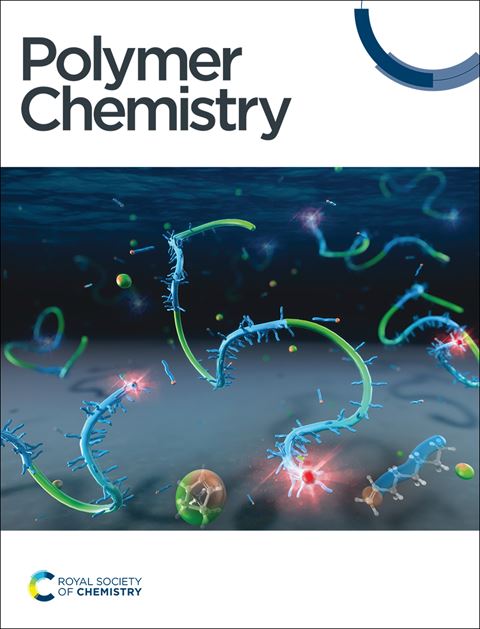Unveiling the zwitterionic nature of an ethyl piperazine-based dithiocarbamate chain transfer agent for achieving high molar mass polyvinyl acetate: experimental and computational insights†
IF 4.1
2区 化学
Q2 POLYMER SCIENCE
引用次数: 0
Abstract
Vinyl acetate (VAc) is one of the least active unconjugated monomers among the less activated monomers (LAMs), resulting in highly reactive and unstable propagating radicals. A significant obstacle in achieving well-defined high molar mass polyvinyl acetate (PVAc) is the occurrence of chain transfer reactions during radical polymerization. Towards the controlled polymerization of VAc, we have employed two different dithiocarbamate-based chain transfer agents and bearing ethyl piperazine and pyrrole as Z stabilizing groups, respectively. In , the lone pair of electrons on the nitrogen atom is not delocalized, reducing the double-bond character of the CS bond and enhancing its zwitterionic nature. Conversely, in the pyrrole-based , the nitrogen's lone pair of electrons will be delocalized within the aromatic system of the Z group, resulting in a less zwitterionic nature. exhibited excellent control over VAc polymerization, yielding a high molar mass of 132 kDa with a low dispersity of 1.31. In contrast, showed poor control when attempting high molar mass VAc polymerization. This observable change in the polymerization behaviour with and can be attributed to the availability of a lone pair of electrons on the nitrogen of the stabilizing Z group, which deactivates the thiocarbonyl group by reducing its double bond character. To understand the underlying reasons, ab initio and DFT calculations were conducted to investigate the neutral or zwitterionic forms of and . The Mulliken charges on each atom and the β-scission of the S–R bond in these RAFT-adduct radicals of both CTAs were measured. The results revealed that exists in a zwitterionic form, while remains in a neutral form, explaining the superior performance of in VAc polymerization. The other thermodynamic aspects of the S–R β-scission of RAFT-adduct radicals of and were also calculated to support the above hypothesis.

揭示乙基哌嗪基二硫代氨基甲酸酯链转移剂的两性离子性质以获得高摩尔质量的聚醋酸乙烯酯:实验和计算见解
醋酸乙烯酯(VAc)是低活性单体(lam)中活性最低的非共轭单体之一,它会产生高活性和不稳定的自由基。实现明确的高摩尔质量聚氯乙烯(PVAc)的一个重要障碍是在自由基聚合过程中链转移反应的发生。为了控制Vac的聚合,我们采用了两种不同的基于二硫代氨基甲酸酯的链转移剂CTA-1和-2,分别含乙基哌嗪和吡咯作为Z稳定基团。在CTA-1中,氮原子上的孤对电子没有离域,降低了C=S键的双键性质,增强了其两性离子性质。相反,在吡咯基的CTA-2中,氮的孤对电子将在Z基团的芳族体系中离域,导致两性离子性质较差。CTA-1对VAc聚合具有良好的控制作用,其摩尔质量高达132 kDa,分散性低1.31。相比之下,CTA-2在尝试高摩尔质量的VAc聚合时表现出较差的控制力。这种可观察到的与CTA-1和-2的聚合行为的变化可归因于稳定Z基团的氮上的孤对电子的可用性,通过降低其双键特征来使硫羰基失活。为了了解潜在的原因,进行了ab-initio和DFT计算,以研究CTA-1和CTA-2的中性或两性离子形式。测量了两种cta的raft加合自由基中每个原子上的Mulliken电荷和S-R键的β-断裂。结果表明,CTA-1以两性离子形式存在,而CTA-2以中性形式存在,这解释了CTA-1在VAc聚合中的优越性能。对CTA-1和CTA-2的raft -加合自由基S-R β-断裂的其他热力学方面也进行了计算,以支持上述假设。
本文章由计算机程序翻译,如有差异,请以英文原文为准。
求助全文
约1分钟内获得全文
求助全文
来源期刊

Polymer Chemistry
POLYMER SCIENCE-
CiteScore
8.60
自引率
8.70%
发文量
535
审稿时长
1.7 months
期刊介绍:
Polymer Chemistry welcomes submissions in all areas of polymer science that have a strong focus on macromolecular chemistry. Manuscripts may cover a broad range of fields, yet no direct application focus is required.
 求助内容:
求助内容: 应助结果提醒方式:
应助结果提醒方式:


